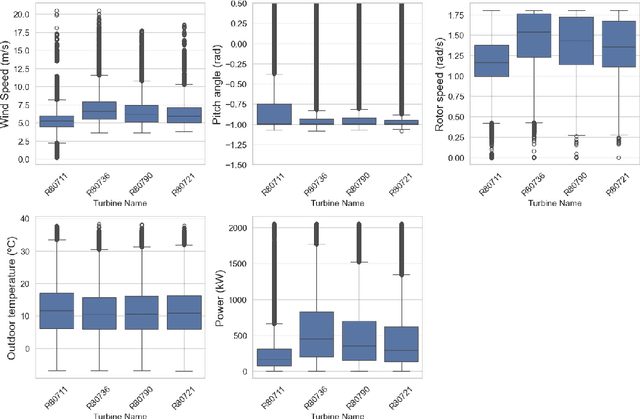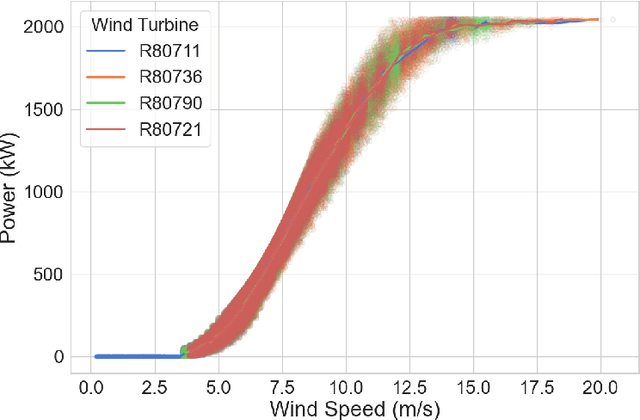Alfonso Gijón
Integrating Physics and Data-Driven Approaches: An Explainable and Uncertainty-Aware Hybrid Model for Wind Turbine Power Prediction
Feb 11, 2025



Abstract:The rapid growth of the wind energy sector underscores the urgent need to optimize turbine operations and ensure effective maintenance through early fault detection systems. While traditional empirical and physics-based models offer approximate predictions of power generation based on wind speed, they often fail to capture the complex, non-linear relationships between other input variables and the resulting power output. Data-driven machine learning methods present a promising avenue for improving wind turbine modeling by leveraging large datasets, enhancing prediction accuracy but often at the cost of interpretability. In this study, we propose a hybrid semi-parametric model that combines the strengths of both approaches, applied to a dataset from a wind farm with four turbines. The model integrates a physics-inspired submodel, providing a reasonable approximation of power generation, with a non-parametric submodel that predicts the residuals. This non-parametric submodel is trained on a broader range of variables to account for phenomena not captured by the physics-based component. The hybrid model achieves a 37% improvement in prediction accuracy over the physics-based model. To enhance interpretability, SHAP values are used to analyze the influence of input features on the residual submodel's output. Additionally, prediction uncertainties are quantified using a conformalized quantile regression method. The combination of these techniques, alongside the physics grounding of the parametric submodel, provides a flexible, accurate, and reliable framework. Ultimately, this study opens the door for evaluating the impact of unmodeled variables on wind turbine power generation, offering a basis for potential optimization.
STIED: A deep learning model for the SpatioTemporal detection of focal Interictal Epileptiform Discharges with MEG
Oct 30, 2024Abstract:Magnetoencephalography (MEG) allows the non-invasive detection of interictal epileptiform discharges (IEDs). Clinical MEG analysis in epileptic patients traditionally relies on the visual identification of IEDs, which is time consuming and partially subjective. Automatic, data-driven detection methods exist but show limited performance. Still, the rise of deep learning (DL)-with its ability to reproduce human-like abilities-could revolutionize clinical MEG practice. Here, we developed and validated STIED, a simple yet powerful supervised DL algorithm combining two convolutional neural networks with temporal (1D time-course) and spatial (2D topography) features of MEG signals inspired from current clinical guidelines. Our DL model enabled both temporal and spatial localization of IEDs in patients suffering from focal epilepsy with frequent and high amplitude spikes (FE group), with high-performance metrics-accuracy, specificity, and sensitivity all exceeding 85%-when learning from spatiotemporal features of IEDs. This performance can be attributed to our handling of input data, which mimics established clinical MEG practice. Reverse engineering further revealed that STIED encodes fine spatiotemporal features of IEDs rather than their mere amplitude. The model trained on the FE group also showed promising results when applied to a separate group of presurgical patients with different types of refractory focal epilepsy, though further work is needed to distinguish IEDs from physiological transients. This study paves the way of incorporating STIED and DL algorithms into the routine clinical MEG evaluation of epilepsy.
Prediction of wind turbines power with physics-informed neural networks and evidential uncertainty quantification
Jul 27, 2023Abstract:The ever-growing use of wind energy makes necessary the optimization of turbine operations through pitch angle controllers and their maintenance with early fault detection. It is crucial to have accurate and robust models imitating the behavior of wind turbines, especially to predict the generated power as a function of the wind speed. Existing empirical and physics-based models have limitations in capturing the complex relations between the input variables and the power, aggravated by wind variability. Data-driven methods offer new opportunities to enhance wind turbine modeling of large datasets by improving accuracy and efficiency. In this study, we used physics-informed neural networks to reproduce historical data coming from 4 turbines in a wind farm, while imposing certain physical constraints to the model. The developed models for regression of the power, torque, and power coefficient as output variables showed great accuracy for both real data and physical equations governing the system. Lastly, introducing an efficient evidential layer provided uncertainty estimations of the predictions, proved to be consistent with the absolute error, and made possible the definition of a confidence interval in the power curve.
 Add to Chrome
Add to Chrome Add to Firefox
Add to Firefox Add to Edge
Add to Edge